Claus Haxholm & Robin Rådenman - New Homes and Ways of Communication (2007)
Thursday, January 31, 2008

New Homes and Ways of Communication is a collaboration between Claus Haxholm from Copenhagen and Robin Rådenman from Stockholm.
The work consists of a booklet/pamphlet and two sound pieces.
Download this at KaraGarga.
myspace.com/claushaxholm
myspace.com/weweredancing
at 11:50 PM
Bernadette Corporation - Get Rid of Yourself (2003)
Wednesday, January 30, 2008
Download this via KaraGarga.
Bernadette Corporation has agreed to let Art Torrents distribute Get Rid of Yourself.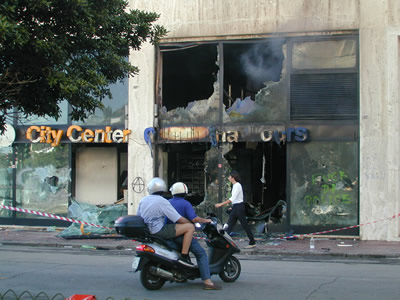
(2003, DV, 61 min, featuring Chloe Sevigny and Werner von Delmont)
Get Rid of Yourself is a video-film-tract addressed to those who anonymously embody the return of political activism within Empire. While its initial sounds and images were filmed during the riots in Genoa, 2001, these materials are pulled apart and recomposed in order to locate the intensity of a shared experience, rather than producing one more documentary version of the programmed and hyper-mediatized confrontation of the G8 counter-summit. Elaborating a complex and rhythmic form of address via sound/image disjunctions, cheap video effects and performance, the film declares its own exile from a biopolitical space-time where nothing ever happens. The crisis it announces is the sudden return of history, but this time without characters or a story, and of a politics without subjects.
Provisionally aligning itself with the so-called ‘Black Bloc' movement – with the arrogance of its discourse as well as the force and style of their resistance – Get Rid of Yourself is an encounter with emerging, non-instituted or identity-less forms of protest that refuse the representational politics of the official Left. Edited in the aftermath of 9/11 - a period of doubt, reflection and heightened security measures worldwide – the film also attempts to measure the strange distance these events have crossed, and the increasing repression under which the feeling of ‘civil war' has been buried in the meantime. A filmed essay that works by betraying its own form, Get Rid of Yourself tries to approach what is most open in an event, rather than capturing and completing it as something recognizable.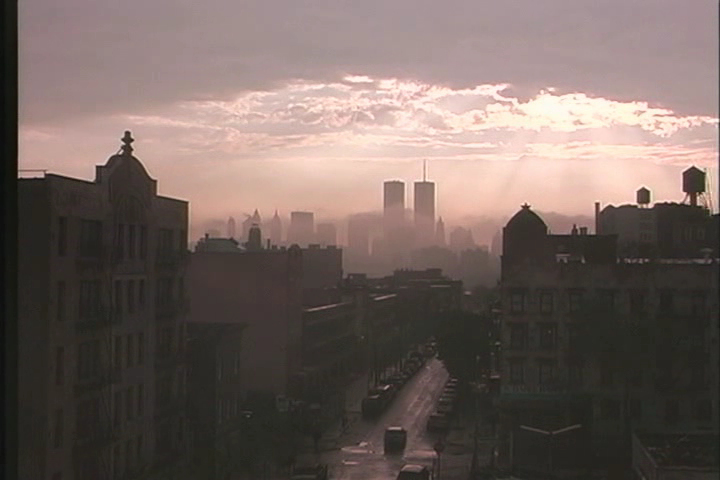


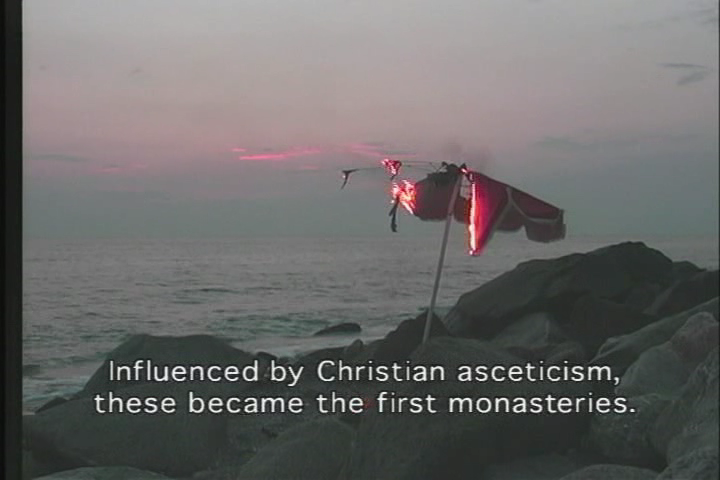
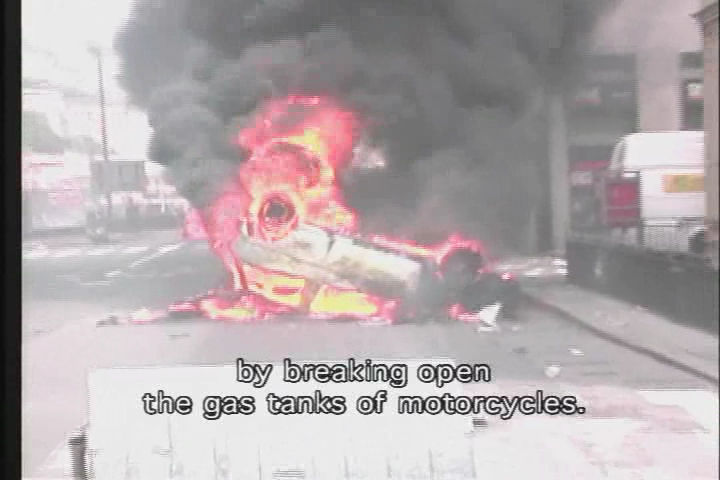

List of screenings to date
2005
- Globalization / War , Institute for Contemporary Art (ICA), Boston
- In the poem about love you don't write the word love , Centre for Contemporary Art, Glasgow
- Argosfestival 2005 , Argos Centre for Contemporary Art, Brussels
- Hammer Forum: Bernadette Corporation , Hammer Museum, Los Angeles
- Documentary Frontiers , Union Theater, University of Wisconson, Milwaukee
- Seminal works from the 20th century: Activism , Whitechapel Art Gallery, London
- Artistes et Cinéastes Entre Fiction et Documentaire , organisé par le Centre Pompidou au FIPA-Biarritz (Festival International de la Production Audiovisuelle)
2004
- Get Rid of Yourself and Saute Ma Ville , special screening during a Chantal Ackerman retrospective at Cinematexas, Austin, Texas
- Prospectif Cinéma , Centre Pompidou
- marx' gespenster / RAF' gespenster , Universität der Künste Berlin (UdK)
- New Filmmakers, Anthology Film Archives, New York
- FID hors murs , Marseille
2003
- Passerby , Gavin Brown's Enterprise, NYC
- What the Fuck is Communism? , L'Institut Jean Vigo et L'Ecole Superieure d'art de Perpignan
- Plans to Desert the Overview , Hebbel Theater, Berlin
- Filmstudio der Hochschule für Bildende Künste, Braunschweig
- Havana Biennale Video Program, Havana, Cuba
- Dresden Postplatz, Dresden
- Video 6: Real Utopia , Galerie fur Landschaftkunst, Hamburg
- Camera Novo , Festival International Documentaire, Marseille
- Film Casino (organized by the Academy of Fine Arts, Vienna), Vienna
- Montag praxis , b-books, Berlin
- B-movie (organisé par l'école de Beaux arts Hambourg), Hambourg
- Edith Russ Site for Media Art, Oldenburg
- PointLignePlan , la Fémis, Paris
2002
- Die Kraft der Negation , organisé par Diedrich Diedrichson, Theatre der Welt festival, Cologne et Berlin
Download this via KaraGarga.
at 12:07 PM
Yvonne Rainer - Journeys from Berlin/1971 (1980)
Download this via KaraGarga.
Rainer's fourth film, and some say her finest, an essay on radicalism and rehabilitation.
How are oppositional politics advanced by their partisans and neutralised by the State? Radicals are those who expose hidden repressive tendencies in a society. Their tactics are criminalized, politics psychologized and reforms bureacratized.
Rainer's film questions duplicitous rehabilitation (psychiatric care/control), the efficacy of radicalism, and conflicted political and personal motivations.
The collage essay technique of Journeys parallels the investigation of these conflicts on a formal level. She weaves the stories of 19th century Russian anarchists; the staging of identity as it occurs in therapeutic analysis, writing a diary or preparing a meal; and the fate of the Red Army Faction (Baader-Meinhof gang), which exposed the precarious and enforced nature of West German democratic freedoms in the 1970s.
Featuring Annette Michelson, Amy Taubin, Vito Acconci, Cynthia Beatt, Ilona Halberstadt, Vernon Gabor, Yvonne Rainer and many others.
Journeys From Berlin/1971 (1980), her epic meditation on psychoanalysis, the Baader-Meinhof, feminism, and pre-revolutionary Russia. Berlin finds its unlikely star in plummy-voiced academic Annette Michelson, whose stream-of-consciousness shrink sessions unearth eggheady gems. "My cunt is not a castrated cock," Michelson protests. "If anything, it's a heartless asshole."




When Yvonne Rainer made her first feature-length film in 1972, she had already influenced the world of dance and choreography for nearly a decade. From the beginning of her film career she inspired audiences to think about what they saw, interweaving the real and fictional, the personal and political, the concrete and abstract in imaginative, unpredictable ways. Her bold feminist sensibility and often controversial subject matter, leavened with a quirky humor, has made her, as the Village Voice dubbed her in 1986, “The most influential American avant-garde filmmaker of the past dozen years, with an impact as evident in London or Berlin as in New York.”
Rainer was born in San Francisco in 1934. She trained as a modern dancer in New York from 1957 and began to choreograph her own work in 1960. She was one of the founders of the Judson Dance Theater in 1962, the beginning of a movement that proved to be a vital force in modern dance in the following decades. Between 1962 and 1975 she presented her choreography throughout the United States and Europe, notably on Broadway in 1969, in Scandinavia, London, Germany, and Italy between 1964 and 1972, and at the Festival D’Automne in Paris in 1972. In 1968 she began to integrate short films into her live performances, and by 1975 she had made a complete transition to filmmaking.
In 1972 she completed a first feature-length film, LIVES OF PERFORMERS. In all she has completed seven features: FILM ABOUT A WOMAN WHO... (1974), KRISTINA TALKING PICTURES (1976), JOURNEYS FROM BERLIN/1971 (1980, co-produced by the British Film Institute and winner of the Special Achievement Award from the Los Angeles Film Critics’ Association), THE MAN WHO ENVIED WOMEN (1985), PRIVILEGE (1990, winner of the Filmmakers’ Trophy at the Sundance Film Festival, Park City. Utah, 1991, and the Geyer Werke Prize at the International Documentary Film Festival in Munich, 1991), and MURDER and murder (1996).
Rainer’s films have been shown extensively in the U.S. and throughout the world, in alternative film exhibition showcases and revival houses (such as the Bleecker St Cinema, Roxy-S.F., NuArt-L.A, Film Forum-NYC, et al), in museums and in universities. Her films have also been screened at festivals in Los Angeles (Filmex), London, Montreux, Toronto, Edinburgh, Mannheim, Berlin, Locarno, Rotterdam, Creteil, Deauville, Toulon, Montreal, Hamburg, Salsa Majori, Figueira da Foz, Munich, Vienna, Athens (Ohio), Sundance, Hong Kong, Yamagata, and Sydney.




Dancer, choreographer, performer, filmmaker and writer Yvonne Rainer, who began choreographing in 1961 and made her first film in 1967, is a key figure in the story of the New York avant-garde in terms of both her writing and practice. (2) Rainer provided a commentary on the influences that preceded her own aesthetic objectives and articulated her own project through practice and explicatory discourse, establishing her position as a key player within the New York avant-garde from the early 1960s through to the mid-1990s. During this period she produced twelve films, including silent short works for multimedia performances (which she calls “filmed choreographic exercises”) (3) as well as features. According to Rainer, her fascination with dance and film emerged simultaneously when she moved on from acting at 25 (p. 51). She is certainly a choreographer who had as many film reference points as choreographic, evidenced in the use of projection in her stage work and her erudite use of cinematic quotation in her film work. (4) What links Rainer's dance and film work is an intense critique of disciplinary conventions and a profound interrogation of the role of performance. Performance is central to all aspects of Rainer's work; she herself refers to performance as the subject matter in her films (p. 8) and Peggy Phelan describes her writings as “rhetorical performances”. (5)
Rainer's parents were migrants, her mother Polish-Jewish (“a potential stage mother”) and her father Italian (“an anarchist and a house painter”), who settled in San Francisco. Rainer describes herself as a shy child who liked to read and her childhood as “depressed”. (6) At around 15 she started attending socialist-anarchist meetings with her brother where she made friends with some visiting New Yorkers. At 20 Rainer “fell into” acting school at the Theater Arts Colony in San Francisco, but after some frustrations there she moved to New York with a painter, Al Held. There she became involved in the visual arts scene and continued acting classes, now at the Herbert Berghof school where she was told she was “too intellectual” (pp. 49–50). Rainer started full-time training at the Martha Graham School at 25 and danced full-time with the support of her parents, spending her spare time at the Museum of Modern Art watching film classics. She moved on to Merce Cunningham's classes and then became part of an informal collective meeting in the Cunningham studios who would work together and perform for each other.
Rainer became a central figure in the American postmodern dance movement, specifically the New York activity surrounding the venue, Judson Church. Following Merce Cunningham's lead, Judson Dance Theatre was inclusive of artists working in other disciplines. Filmmaking was particularly predominant at Judson Dance Theatre events and Sally Banes describes this area as a “key outgrowth” of the group. (7) A film work, by regular contributor Elaine Summers and others, opened the very first Judson performance and within the series there were other screenings including Brian De Palma's 1963 film, Wotan's Wake (which parodies Maya Deren among other things). (8) Peter Wollen and Vicky Allan have written that experimental filmmakers have always been “interested in analogies between dance and film as kinetic and time-based art forms”, (9) and in the case of the '60s and '70s, choreographic and film/video strategies can be discussed as concomitant with the two disciplines informing and elaborating on each other. Along with De Palma, other filmmakers such as Charles Atlas, Shirley Clarke, Amy Greenfield, Doris Chase and Hilary Harris worked with dance and dancers. (10) Rainer ultimately states, however, that her influences were from outside the experimental film scene; that she was familiar with the work of Maya Deren and filmmakers such as Stan Brakhage and Kenneth Anger, but “the ideas didn't really turn me on the way that [John] Cage's ideas in music and '60s art practices had.” (11)
Download this via KaraGarga.
at 10:11 AM
Marina Abramovic & Ulay - Relation Work (1976 - 1979)
Download this via KaraGarga.
Relation Work, 1976-1979: 14 performances
Contents: Relation in space -- Talking about similarity -- Breathing in, breathing out -- Imponderabilia -- Expansion in space -- Relation in movement -- Relation in time -- Light/Dark -- Balance proof -- AAA-AAA -- Incision -- Kaiserschnitt -- Charged space -- Three.
Performance art pieces illustrating art in confrontation with life and the individual versus the universal by early performance artists, Ulay and Marina Abramovic. 1996. 148 min.
violent. infuriating. hypnotic. arresting.
the isprobably the single most important collection of historical performance art
quality is acceptable. 14 performances.
2 1/2 hours long
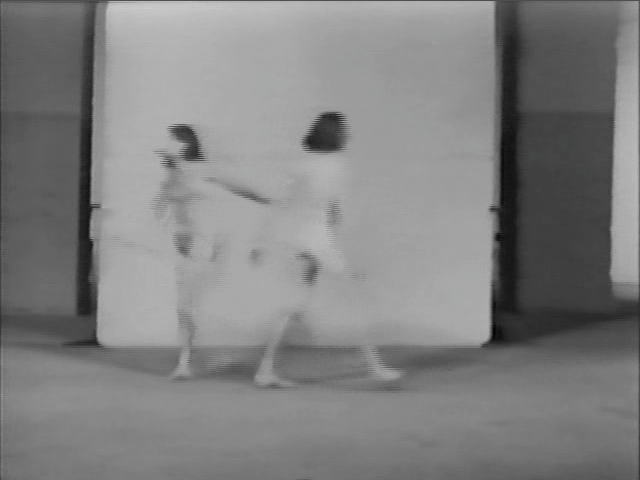
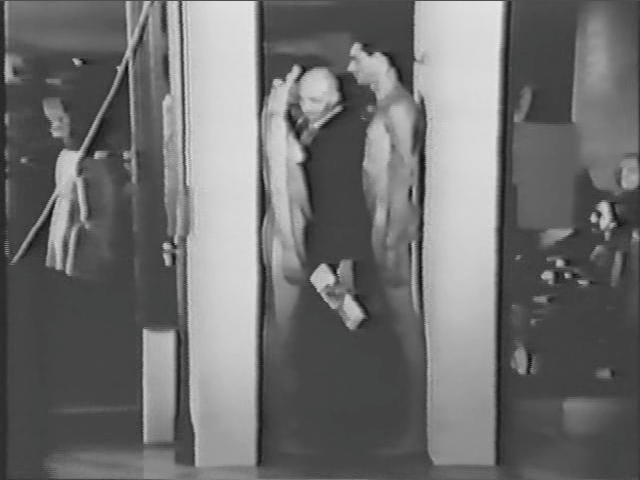
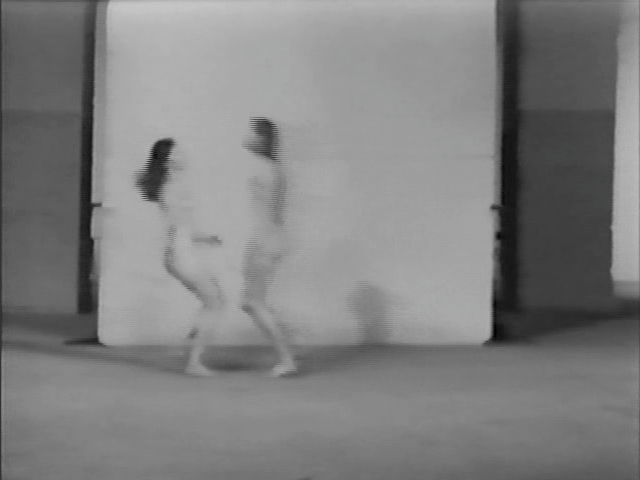
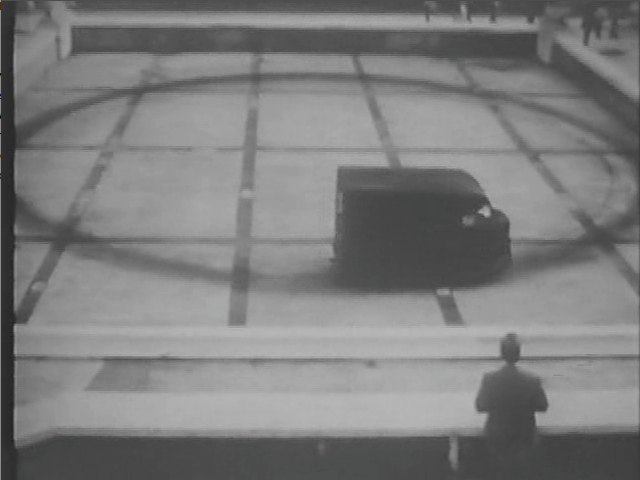
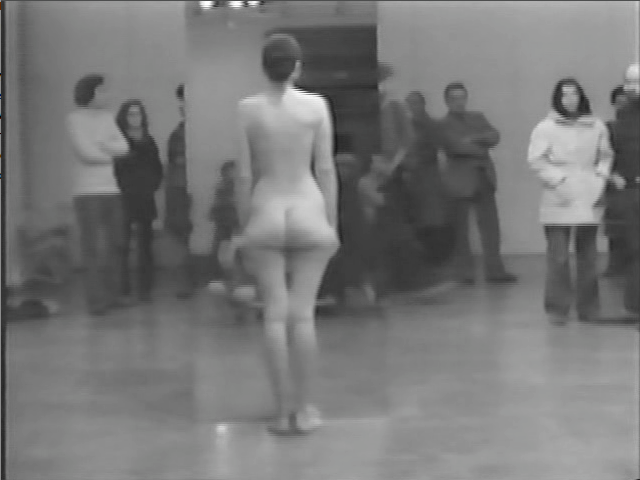
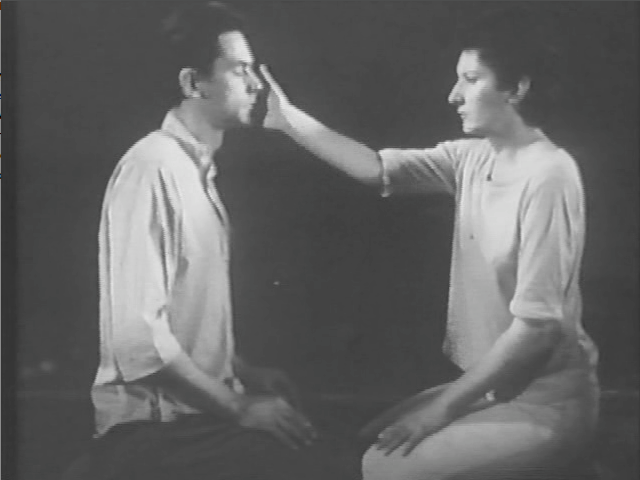





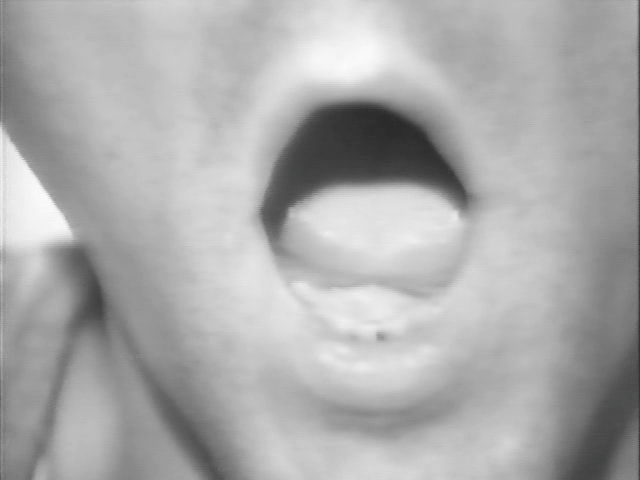

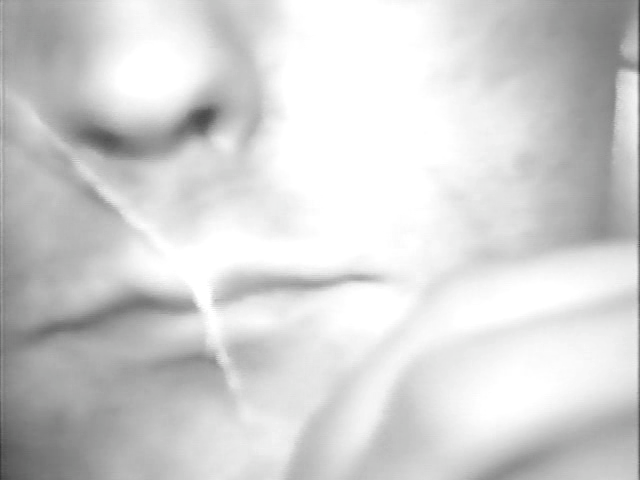
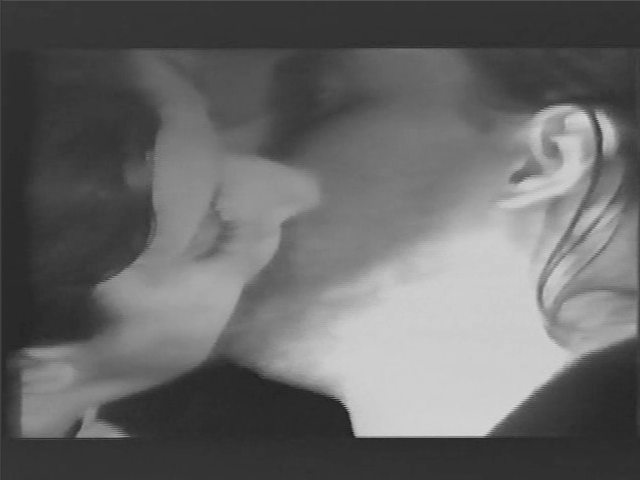

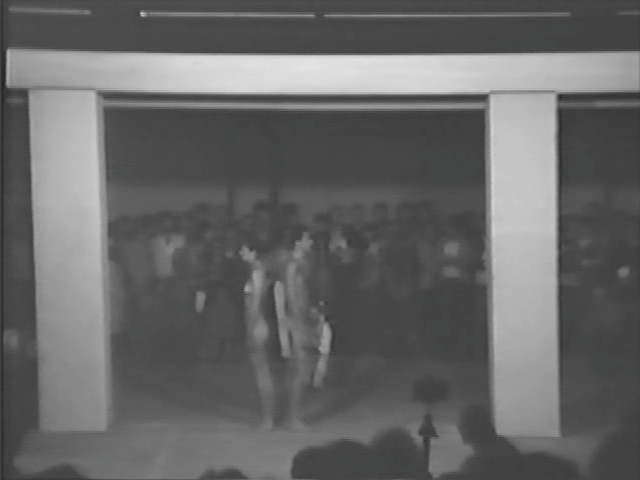
Download this via KaraGarga.
at 10:07 AM
Marina Abramovic - Four Performances (1975-1976)
Download this via KaraGarga.
4 Performances by Marina Abramovic, 1975-1976
Art must be beautiful, Artist must be beautiful.
Freeing the voice
Freeing the memory
Freeing the body.
Galerie Mike Steiner, Berlin, December, 1976.
54 min.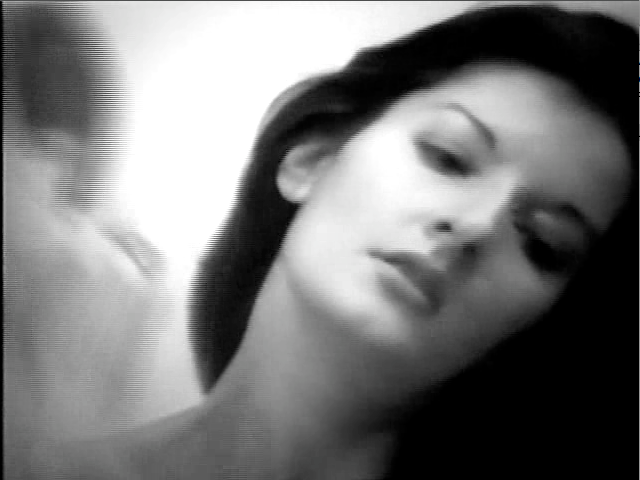
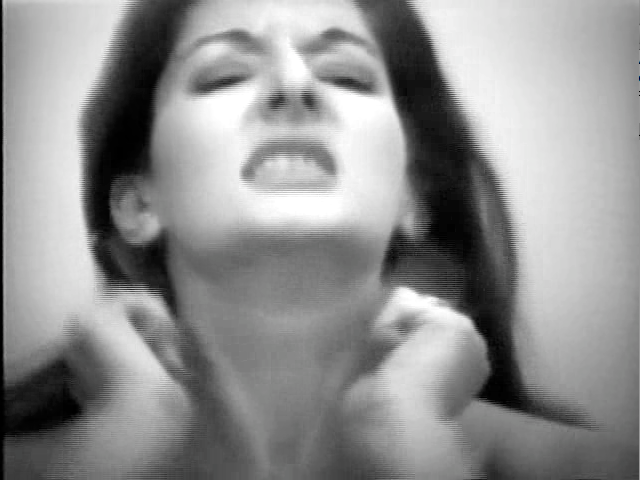
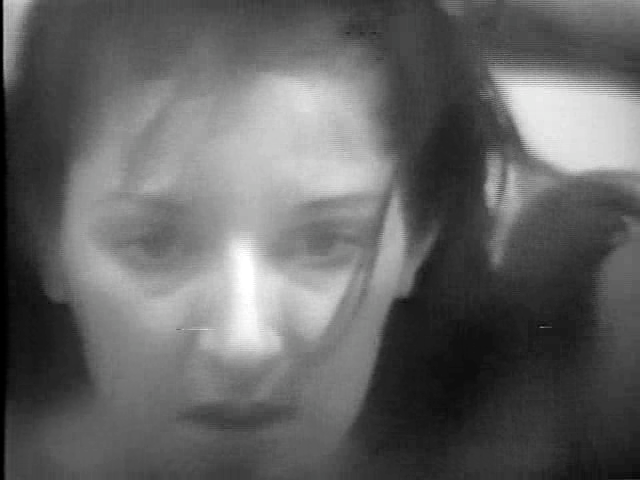
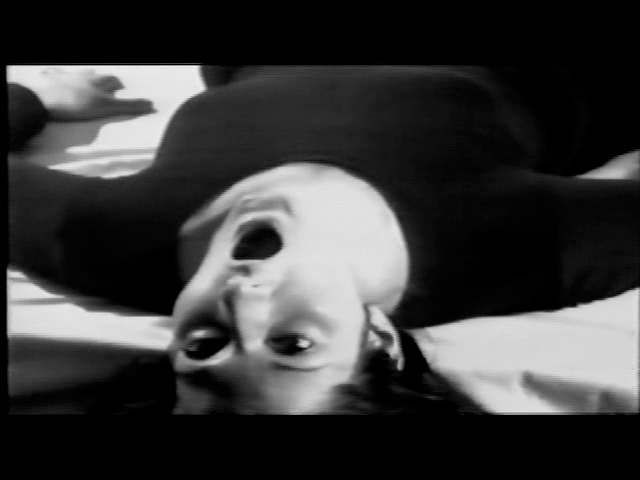
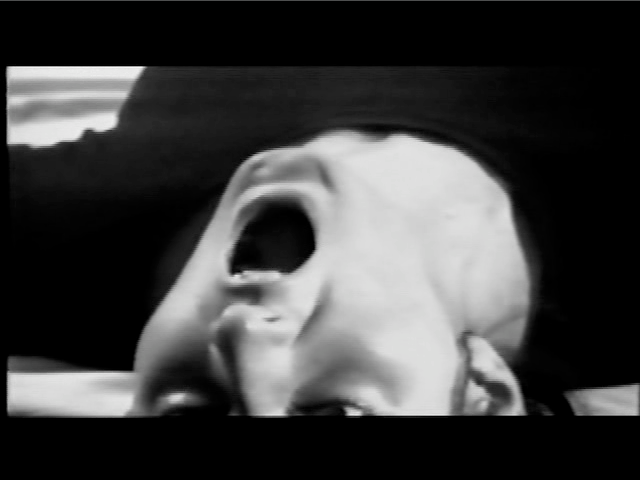
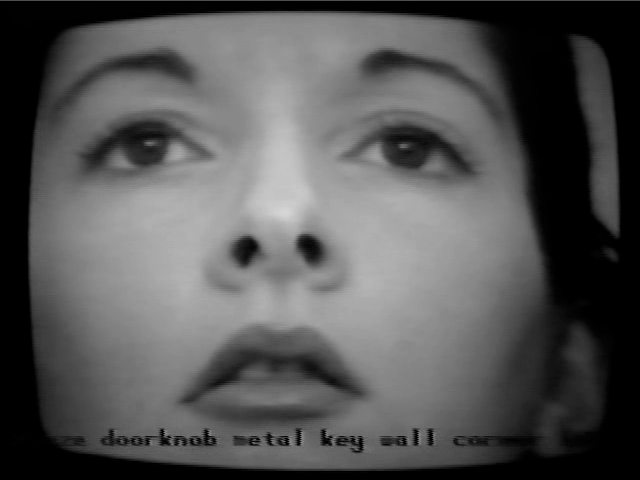
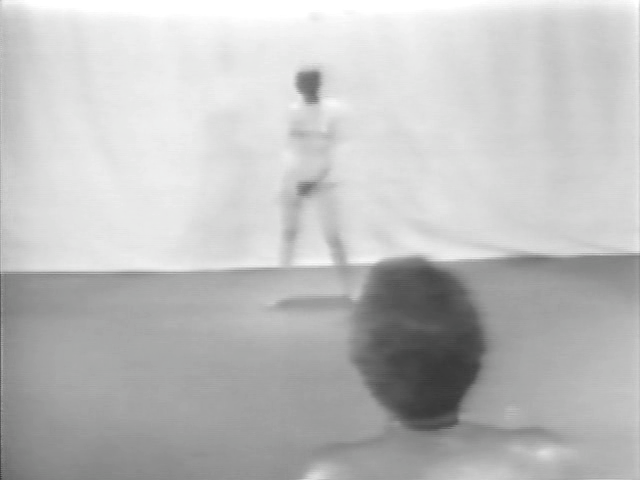

Early life
Marina Abramović's grandfather was a patriarch of the Serbian Orthodox church. After his death he was proclaimed a saint, embalmed, and placed in St. Sava's Church in Belgrade. Both of her parents were partisans during the Second World War : her father Vojo was a commander who was acclaimed as a national hero after the War; her mother Danica was a major in the army, and in the mid-sixties was Director of the Museum of the Revolution and Art in Belgrade.
Abramović's father left the family in 1964. In an interview published in 1998, she described how her "mother took complete military-style control of me and my brother. I was not allowed to leave the house after 10 o'clock at night till I was 29 years old. ... [A]ll the performances in Yugoslavia I did before 10 o'clock in the evening because I had to be home then. It's completely insane, but all of my cutting myself, whipping myself, burning myself, almost losing my life in the firestar, everything was done before 10 in the evening." (Quoted in Thomas McEvilley, "Stages of Energy: Performance Art Ground Zero?" in Abramović, Artist Body, [Charta, 1998])
Abramović was a student at the Academy of Fine Arts in Belgrade from 1965-70. She completed her post-graduate studies at the Academy of Fine Arts in Zagreb, Croatia in 1972. From 1973 to 1975 she taught at the Academy of Fine Arts at Novi Sad, while implementing her first solo performances.
In 1976 Abramović left Yugoslavia and moved to Amsterdam.
Selected early works
Rhythm 10, 1973
In her first performance Abramović explored elements of ritual and gesture. Making use of ten knives and two tape recorders, the artist played the Russian game in which rhythmic knife jabs are aimed between the splayed fingers of her hand. Each time she cut herself, she would pick up a new knife from the row of ten she had set up, and recorded the operation.
After cutting herself ten times, she replayed the tape, listened to the sounds, and tried to repeat the same movements, attempting to replicate the mistakes, merging together past and present. She set out to explore the physical and mental limitations of the body – the pain and the sounds of the stabbing, the double sounds from the history and from the replication. With this piece, Abramovic began to consider the state of consciousness of the performer. “Once you enter into the performance state you can push your body to do things you absolutely could never normally do.” (Kaplan, 9)
Rhythm 5, 1974
Abramović sought to re-evoke the energy of extreme body pain, in this case using a large petroleum-drenched star, which the artist lit at the start of the performance. Standing outside the star, Abramovic cut her nails, toenails, and hair. When finished with each, she threw the clippings into the flames, creating a burst of light each time. Burning the communist five-four rayed star represented a physical and mental purification, while addressing the political traditions of her past.
In the final act of purification, Abramović leapt across the flames, propelling herself into center of the large star. Due to the light and smoke given off by the fire, the observing audience didn’t realize that, once inside the star, the artist had lost consciousness due to a lack of oxygen. Some members of the audienced realized what had occurred only when the flames came very near to her body and she remained inert. A doctor and several members of the audience intervened and extricated her from the star.
Abramović later commented upon this experience: “I was very angry because I understood there is a physical limit: when you lose consciousness you can’t be present; you can’t perform.” (Daneri, 29).
Rhythm 2, 1974
As an experiment testing whether a state of unconsciousness could be incorporated into a performance, Abramović devised a performance in two parts.
In the first part, she took a pill prescribed for catatonia, a condition in which a person’s muscles are immobilized and remain in a single position for hours at a time. Being completely healthy, Abramović's body reacted violently to the drug, experiencing seizures and uncontrollable movements for the first half of the performance. While lacking any control over her body movements, her mind was lucid, and she observed what was occurring.
Ten minutes after the effects of that drug had worn off, Abramović ingested another pill--this time one prescribed for aggressive and depressed people--which resulted in general immobility. Bodily she was present, yet mentally she was completely removed. (In fact, she has no memory of the lapsed time.) This project was an early component of her explorations of the connections between body and mind, which later took her to Tibet and the Australian desert Following Rhythm 2, she set to develop the rest of the series of rhythm projects, continually testing her endurance.
Rhythm 0, 1974
To test the limits of the relationship between performer and audience, Abramović developed one of her most challenging (and best-known) performances. She assigned a passive role to herself, with the public being the force which would act on her.
Abramović had placed upon a table 72 objects that people were allowed to use (a sign informed them) in any way that they chose. Some of these were objects that could give pleasure, while others could be wielded to inflict pain, or to harm her. Among them were scissors, a knife, a whip, and, most notoriously, a gun and a single bullet. For six hours the artist allowed the audience members to manipulate her body and actions.
Initially, members of the audience reacted with caution and modesty, but as time passed (and the artist remained impassive) several people began to act quite aggressively. As Abramović described it later:
“The experience I learned was that…if you leave decision to the public, you can be killed.” ... “I felt really violated: they cut my clothes, stuck rose thorns in my stomach, one person aimed the gun at my head, and another took it away. It created an aggressive atmosphere. After exactly 6 hours, as planned, I stood up and started walking toward the public. Everyone ran away, escaping an actual confrontation.” (Daneri, 29; and 30).
Works with Ulay (Uwe Laysiepen)
In 1976, after moving to Amsterdam, Abramović met the West German performance artist Uwe Laysiepen, who went by the single name Ulay. They were both born on the same day.
When Abramović and Ulay began their collaboration, the main concepts they explored were the ego and artistic identity. This was the beginning of a decade of influential collaborative work. Each performer was interested in the traditions of their cultural heritages and the individual’s desire for ritual. Consequently, they decided to form a collective being called “the other,” and spoke of themselves as parts of a “two-headed body.” (Quoted in Green, 37). They dressed and behaved like twins, and created a relationship of complete trust. As they defined this phantom identity, their individual identities became less accessible. In an analysis of phantom artistic identities, Charles Green has noted that this allowed a deeper understanding of the artist as performer, for it revealed a way of “having the artistic self made available for self-scrutiny.” (41)
While some critics have explored the idea of a hermaphroditic state of being as a feminist statement, Abramović herself denies considering this as a conscious concept. Her body studies, she insists, have always been concerned primarily with the body as the unit of an individual, a tendency she traces to her parents' military pasts. Rather than concern themselves with gender ideologies, Abramović/Ulay explored extreme states of consciousness and their relationship to architectural space. They devised a series of works in which their bodies created additional spaces for audience interaction. In "Relation in Space" (1976) they ran around the room - two bodies like two planets, mixing male and female energy into a third component called “that self.” "Relation in Movement" had the pair drive their car inside of a museum for 365 laps; a black liquid oozed from the car, forming a kind of sculpture, each lap representing a year. (After 365 laps they entered the New Millennium.)
In discussing this phase of her performance history, Abramović has said: “The main problem in this relationship was what to do with the two artists’ egos. I had to find out how to put my ego down, as did he, to create something like a hermaphroditic state of being that we called the death self.” (Kaplan, 14)
To create this “Death self,” the two performers devised a piece in which they connected their mouths and took in each other’s exhaled breaths until they had used up all of the available oxygen. Seventeen minutes after the beginning of the performance they both fell to the floor unconscious, their lungs having filled with carbon dioxide. This personal piece explored the idea of an individual's ability to absorb the life of another person, exchanging and destroying it.
In 1988, after several years of tense relations, Abramović and Ulay decided to make a spiritual journey which would end their relationship. Each of them walked the Great Wall of China, starting from the two opposite ends and meeting in the middle. As Abramovic described it: “That walk became a complete personal drama. Ulay started from the Gobi desert and I from the Yellow Sea. After each of us walked 2500 km, we met in the middle and said good-bye.” (Daneri 35)
Abramović conceived this walk in a dream, and it provided what she thought was an appropriate, romantic ending to a relationship full of mysticism, energy and attraction. She later described the process: “We needed a certain form of ending, after this huge distance walking towards each other. It is very human. It is in a way more dramatic, more like a film ending … Because in the end you are really alone, whatever you do.” (Daneri, 35)
Abramović reported that during her walk she was reinterpreting her connection to the physical world and to nature. She felt that the metals in the ground influenced her mood and state of being; she also pondered the Chinese myths in which the great wall has been described as a “dragon of energy.”
Download this via KaraGarga.
at 10:03 AM
Dara Birnbaum - Technology/Transformation: Wonder Woman (1978)
Tuesday, January 29, 2008
Download this via KaraGarga.
Dara Birnbaum is an American video artist who is perhaps most famous for her provocative and influential contributions to the contemporary discourse on art and popular culture. Through video works and multi media installations, Birnbaum subverts, critiques and deconstructs hegemony of mass media images and gestures to confront the mythologies of culture and history. If we define appropriation as an act that takes possession of another’s imagery or idea, often without permission, then Dara Birnbaum fits the bill.
[Technology/Transformation: Wonder Woman, 1978-79, video, Electronic Arts Intermix, NY.]
In her video Technology/Transformation: Wonder Woman, Dara Birnbaum created one of the first examples of appropriation imagery from mainstream television, something that is now quite common. Technology/Transformation: Wonder Woman, features, as one might expect, Wonder Woman, the main character of the prime-time television programm of the same name which was based on an action-adventure comic book. Using actual sceans from the series, Birnbaum “plung[es] the viewer headlong into the ver experience of TV- unveiling TV’s steriotypical gestures of power and submission, of male and female egos.” -
Birnbaum isolates and repeats the moments of the ‘real’ womans transformation into superhero. In doing so, Birnabaum is subverting its meaning within the television context. She is also appropriating televison filming conventions to deconstruct the idiomatic meaning of televisions structural codes, she uses these to anayze the syntax and gestures of what Birnbaum calls “TV treatmeant”.
Explosive bursts of fire open Technology/Transformation, an incendiary deconstruction of the ideology embedded in television form and pop cultural iconography. Appropriating imagery from the TV series Wonder Woman, Birnbaum isolates and repeats the moment of the "real" woman's symbolic transformation into super-hero. Entrapped in her magical metamorphosis by Birnbaum's stuttering edits, Wonder Woman spins dizzily like a music-box doll. Through radical manipulation of this female Pop icon, she subverts its meaning within the television text. Arresting the flow of images through fragmentation and repetition, Birnbaum condenses the comic-book narrative -- Wonder Woman deflects bullets off her bracelets, "cuts" her throat in a hall of mirrors -- distilling its essence to allow the subtext to emerge. In a further textual deconstruction, she spells out the words to the song Wonder Woman in Discoland on the screen. The lyrics' double entendres ("Get us out from under ... Wonder Woman") reveal the sexual source of the superwoman's supposed empowerment: "Shake thy Wonder Maker." Writing about the "stutter-step progression of `extended moments' of transformation from Wonder Woman," Birnbaum states, "The abbreviated narrative -- running, spinning, saving a man -- allows the underlying theme to surface: psychological transformation versus television product. Real becomes Wonder in order to "do good" (be moral) in an (a) or (im)moral society."
Technical Assistance: Ed Slopek/Nova Scotia College of Art and Design. Original Television Footage: CBS Inc. "Wonder Woman." Sound: The Wonderland Disco Band.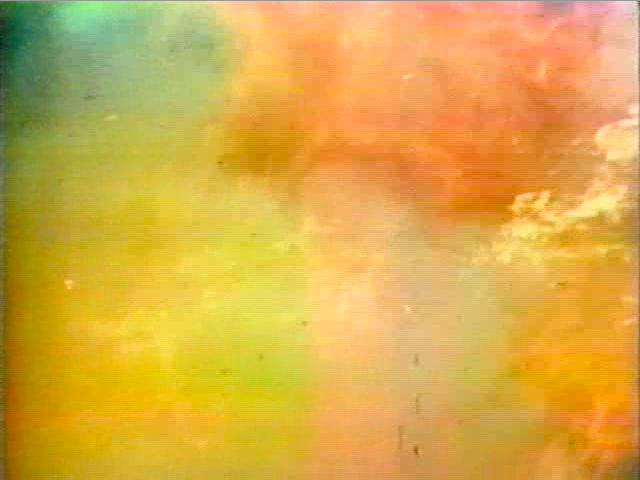
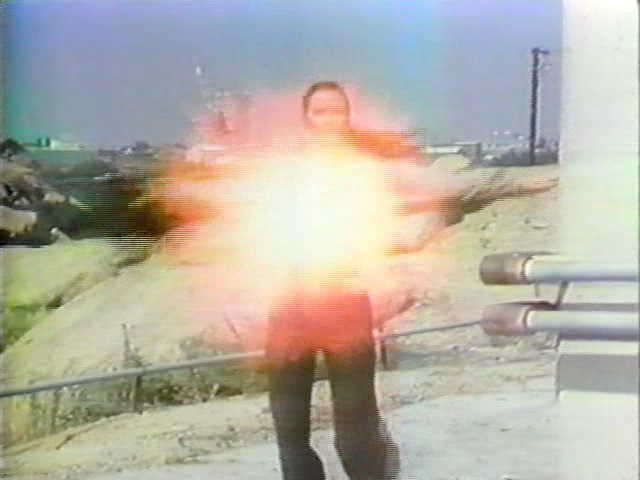

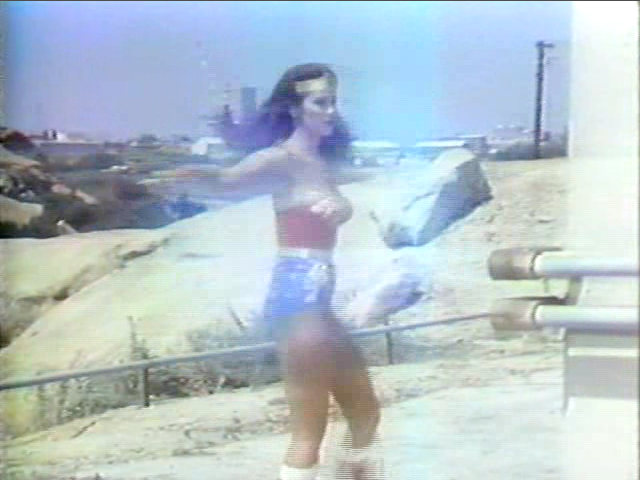
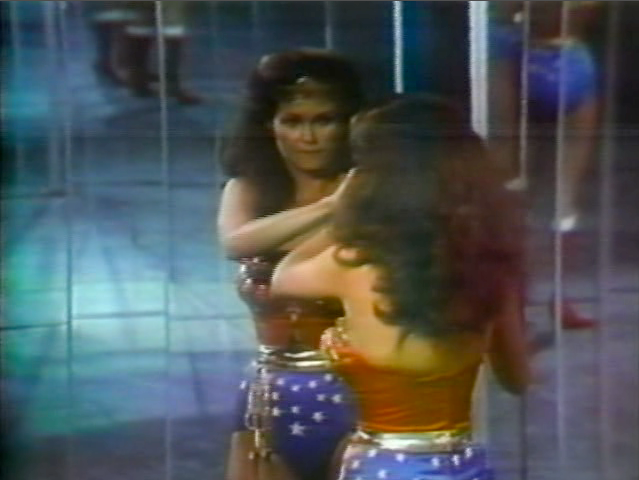
Buchloh, Benjamin. "Dara Birnbaum: Allegorical Procedures." Medij v mediju/Media in Media Ljubljana, Slovenia: 1996. pp. 46-55 + 149,150
Dara Birnbaum. Kunsthalle Wien, Vienna: Verlag Ritter Klagenfurt, 1995.
Detterer, Gabriele. Art Recollection, Artists' Interviews and Statements in the Nineties. Florence: Danilo Montanari & Exit & Zona Archives Editori, 1997.
Ross, David. "Truth or Consequences: American Television and Video Art." Video Culture: A Critical Investigation. Ed. John Hanhardt, Rochester: Studies Workshop Press, 1986. pp. 169-170, 174-178.
Seeing Time: Selections from the Pamela and Richard Kramlich Collection of Media Art. San Francisco: San Francisco Museum of Modern Art, 1999.
"The First Decade: Video From the EAI Archives" at the Museum of Modern Art
by Ed Halter
Village Voice
February 20 - 26, 2002
It's hard to even envision a world without Blockbuster and camcorders, 100 channels of cable TV, Jumbotron billboards, digital cinema, or streaming media—a world before the distracting array of mesmerizing tech developed during the last two decades of hyperactive consumer culture. Prior to the '80s, video wasn't rare, exactly, but its only visible manifestation was the wood-paneled monolith of broadcast television. Art history apocrypha claims that the first challenge to TV's cultural monopoly appeared at the moment of Nam June Paik's purchase of a Portapak in 1965. Entranced by the novelty of artist-made television and the futuristic exhortations of Marshall McLuhan and Buckminster Fuller, underground filmmakers like Andy Warhol, Scott Bartlett, and Jud Yalkut soon began incorporating psychedelic video feedback into their works. The end results, however, were almost always on 16mm film.
The first U.S. gallery exhibition devoted to video as such, at 57th Street's Howard Wise Gallery in 1969, was tellingly entitled "TV as a Creative Medium." Closed-circuit installations showed artgoers the grungy wonders of TV-that-was-not-TV. Inspired by the new art's possibilities, Wise closed his gallery in 1970 and founded Electronic Arts Intermix, a downtown nonprofit created to support the nascent form. Thirty years later, EAI is one of the leading distributors and preservationists of artists' videotapes, firmly established in a world that has now embraced video. A mark of its long-overdue mainstreaming is MOMA's "The First Decade: Video From the EAI Archives," a three-week birthday party celebrating the innovative and ingenious artist-made video of the 1970s.
Although most will be screened theatrically at MOMA, the original works predate video projection, and were created to be displayed on early monitors. "The screen would have been fairly small, rather face-sized," says Lori Zippay, EAI's executive director, who curated the series with MOMA's Barbara London and Sally Berger. "So artists would address the viewer directly, on a one-on-one, human scale." Many of the bare-bones performance tapes—by William Wegman, Dan Graham, Tony Oursler, Martha Rosler, and others—have an intimate but controlled style that favors the one-way monologue. Vito Acconci's "Theme Song" expands this tendency to an annoyingly extreme level, as Acconci leans closely into the camera and drones pretentious faux-seductions for more than a half-hour. Others use the camera as an instrument for cathartic expression, like pain-junkie Chris Burden or minimalist composer Charlemagne Palestine, who took a Portapak on a Coney Island roller coaster, chanting ecstatically through his ritual joyride. In general, though, tapes made to explore structural experiments and image manipulation hold up much better over time. Dara Birnbaum's early culture-jams of Wonder Woman and Hollywood Squares, Steina and Woody Vasulka's visionary electronic abstractions, and Bill Viola's video-cinematic mindtrips still stun with consciousness-raising wit and technophile beauty.
But not all EAI tapes were made just for the gallery. Works by video collectives like Ant Farm, Downtown Community Television, and Raindance preserve a politicized, countercultural view of a changing society. In TVTV's "Four More Years," post-hippie artists invade the 1972 Republican Convention, creating the strange spectacle of far-out chicks grilling Nixon's kids and Henry Kissinger on key policy issues. With today's dearth of intelligent alternatives to tightly controlled mainstream political coverage, it's enough to make you wonder what we've been doing with all this fancy media for the past 20 years. Or, more to the point, what it's been doing with us.
Download this via KaraGarga.
at 9:50 AM
HC Gilje, Kurt Ralske & Lukasz Lysakowski - 242 Pilots: Live in Bruxelles (2002)
Download this via KaraGarga.
242.pilots are hc gilje, (norway), kurt ralske, (usa), and lukasz lysakowski, (poland), three video artists and a revolving set of musicians who perform collaboratively. Using their own custom software, 242.pilots improvise rich, layered video works in real-time (both as a group and as individuals). Improvising as a group, the members respond and interact with each other's images in a subtle and intuitive way, images are layered, contrasted, merged, and transformed.
The interplay and unspoken communication between the artists is akin to a free jazz ensemble. The end product is a 'visual conversation': a quasi-narrative exploring degrees of abstraction; a mesmerizing immersive journey through diverse landscapes.
The New York Times praised their work as "a compelling, intruiging alliance of sound and motion". Since their inception in 2001, 242.pilots have performed at museums, galleries and theaters throughout Europe, Canada, and USA, including the Montreal Museum of Contemporary Art, Impakt Festival in Utrecht, NL, and the Bilbao Guggenheim Museum.
The 242.pilots DVD "Live in Bruxelles" received the Image Award at Transmediale.03 International Media Art Festival in Berlin, February 2003
This DVD is a live recording of the 242.pilots performance at le petit theatre mercelis at the invitation of iMAL in brussels, Belgium on 22.2.2002. the DVD contains a recording of the group performance, three solo pieces, and an interview.
It received the Image Award at Transmediale 2003. The jury statment: «The work is convincing above all in the play of collective live production, the presentation mode of large-scale image production, the contextualisation of live images in the scope of a contemporary image culture and the development of specific technological production tools as well as their distribution. The combined introduction of all of these “production strands” in the space of a collective process finally relativises the still prevalent myth of the image as a form of subjective and subjectcentered activity. 242.pilots through their work, translate in a thoroughly convincing manner the multifarious aspects of image production under the conditions of digital, interactive and network-based media.»



242.pilots real-time video performances
___A selection of performances :
Guggenheim, Bilbao 03.04
mutek,montreal. 05.03
The American Museum of Moving Image, New York City 05.03
selfware.Graz. 04.03
Cornell University,04.03
Transmediale .Berlin .02.03
Podewil .Berlin .11.02
Ultima Festival .Oslo .10.02
Taktlose Festival .Bern .09.02
Galapagos .New York City .06.02
Xl Centre Culturel .Brussels .02.02
Transmediale .Berlin .02.02
Kunstlerhaus .Dortmund .02.02
LAB .Copenhagen .02.02
Museum of Contemporary Art .Montreal .10.01
Impakt Festival .Utrecht .10.01
Steim Institute .Amsterdam .10.01
Off-Corso .Rotterdam .10.01
___Screenings :
computer music days, Hong Kong. 10.03
Transmediale .Berlin .02.03
exploding cinema, seattle. 05.02
European Media Arts Festival, Osnabrueck. 04.02
___The format of 242.pilots performance :
1st half of the performance is a series of solos from Gilje, Ralske and Lysakowski.
Each pilot provides his own music, usually as part of a simultaneous audio-video
improvisation.
2nd half is a trio: the video output from each pilot is layered or combined into one
seamless whole. Music for the trio section is provided by a guest musician.
Total performance time: 1 hour 20 minutes.
This format of presentation allows the audience to absorb each pilots's distinct
style, and to compare and contrast them. Then, the component elements of the
trio mix are then more easily discernable and enjoyable.
The trio performance is accompanied by electronic music, also improvised live.
242.pilots live musical collaborators have included:
Justin Bennett (UK)
Tordis Berstrand (Denmark)
Tim Hecker (Canada)
Download this via KaraGarga.
at 9:47 AM